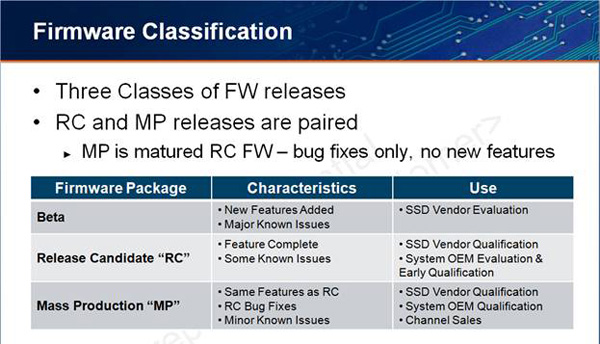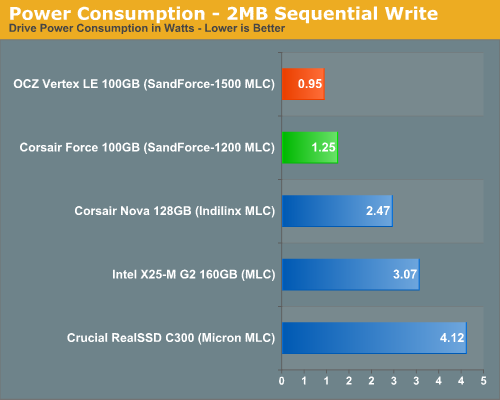Understanding SandForce's SF-1200 & SF-1500, Not All Drives are Equal
by Anand Lal Shimpi on April 16, 2010 11:30 AM ESTIt’s a Mad World: Not All SF-1200s Perform Alike
OCZ was the first from our community to really embrace SandForce. It’s my understanding that the two companies have a very close relationship, and OCZ has committed a lot of resources to SandForce and its products. OCZ took the early risk that others would not. While other companies are working with SF today, OCZ appears to have been the first from the SSD makers we cover on the site.
In exchange for their cooperation and support, SandForce gave OCZ a couple of things. First was the unique SF-1500 used in the Vertex LE at competitive prices (and minus some of the enterprise features). This gave OCZ a huge head start on the competition. The second thing SandForce gave OCZ was the rights to an exclusive firmware for the SF-1200. This firmware would give OCZ the small file random write performance of the SF-1500, but with the rest of the feature set of the SF-1200. This special firmware is going to be used in the upcoming Vertex 2 SSD.
The rest of SandForce’s customers would get the standard SF-1200 firmware, which allows the drive to run at 10,000 sustained 4K random IOPS. Other SF-1200 drives from OCZ, such as the upcoming Agility 2, would also use this standard SF-1200 firmware. The special firmware is only for the Vertex 2 at this point.
SandForce’s firmware has been in release candidate (RC) stage for the past couple of months. Internally SandForce calls this version 3.0.1 and has communicated to all of its partners what RC vs. MP (mass production) firmware entails:

This slide is shared with all SF partners.
Two things are true about this RC firmware: 1) it doesn’t limit small file random write speed on the SF-1200, and 2) there is a known reliability issue that could result in a dead drive (similar to what happened to my Vertex 2 Pro earlier this year).
And here’s where things get messy. SandForce distributed 3.0.1 to all of its partners (so much for that exclusivity agreement), and some of its partners have decided to sample reviewers or even ship based on 3.0.1. Note that even OCZ’s Vertex LE shipped using the SF-1500 version of this firmware. If SandForce indeed distributed the above slide to all of its partners, no drive should've shipped with RC firmware. That's a separate issue entirely and I've been working with both SandForce and the companies involved to see what we can do about curbing this (or at least get me the information so that I can make it clear when a product is using non-MP firmware).
The Corsair Force drive that has been sent out for reviews and that’s currently shipping today uses SandForce’s 3.0.1 firmware.
Naturally, I called up Corsair to figure out what’s going on. Corsair explained to me that the reliability problem was related to a power saving feature on the controller that Corsair simply disabled and thus avoided the issue entirely. I have yet to find a repeatable way to reproduce the bug, but the power data from our testing corroborates what Corsair is saying:

Corsair’s drive uses more power than OCZ’s Vertex LE. While it could be for a number of reasons, it’s apparently due to this power saving feature being disabled. Unless I’m wrong, Corsair appears to have circumvented the known reliability issue and is shipping product it feels is safe into the market.
Now we get to the other problem. The performance of 3.0.1 is the same as OCZ’s exclusive SF-1200 firmware, because the firmwares are the same. However SandForce has recently released its first MP firmware: 3.0.5. This firmware, as you’d expect, caps small file random write performance on all SF-1200 drives except for the Vertex 2 in accordance with SandForce’s agreement with OCZ. The SF-1500 version of this firmware doesn’t change performance, but it does supposedly fix the reliability problems and is available for Vertex LE owners here.
Corsair is currently testing the 3.0.5 revision for its drive but hasn’t shared it with me yet. Corsair wasn’t aware that performance dropped with this revision until I called yesterday. The release notes don’t indicate anything of the sort, Corsair was kept completely in the dark on this. Why didn’t SandForce tell Corsair? Because although it drops performance, the new firmware still runs the SF-1200 at its intended spec. The chip will continue to perform as advertised, just slower than with the RC firmware and slower than OCZ’s Vertex 2.










81 Comments
View All Comments
bplewis24 - Friday, April 16, 2010 - link
It's pretty sad that one of the only places I can go to get real, actual (somewhat investigative) journalism and insight is a tech site. This is great stuff, Anand. Keep up the good work.Brandon
NGneer - Friday, April 16, 2010 - link
Just wondering if the last line on page 2 has a typo regarding MP vs RC or possibly I'm just confused."just slower than with the MP firmware and slower than OCZ’s Vertex 2."
Anand Lal Shimpi - Friday, April 16, 2010 - link
Woops, you're correct :) Fixed.Take care,
Anand
529th - Friday, April 16, 2010 - link
In an infant market segment, it seems Sandforce is trying it's best to get as much user feedback from their product stepping over their exclusive agreements. But it seems OCZ and Corsair are in the same boat with their SF1200 controlled SSD drives. It's basically a morality call from Sandforce that falls on some segment of end-users in order for a company to speed up the development of their firmware for their controllers in order to not fall behind in the best controller war. Q4 is right around the corner for Intel and while the 25nm chips will help even further push their proven conglomerate that makes up their SSD drive lets hope we have a few different companies that keep the prices competitive.cjl - Friday, April 16, 2010 - link
The comment in the article" In a population of 10,000,000 controllers, with a rating of 10,000,000 hours, the probability is that 1 unit would fail in an hour. The SF-1200 would have 5 units fail in the same time. The failure probability drops as the number of controllers drops (SF won’t be shipping anywhere near 10M of these things)."
is flawed in several ways. It assumes a linear failure rate (I.E. that your drive is just as likely to fail in the first hour as it is after 200,000 hours), and it assumes that 100% of drives will fail by the rated lifetime (in other words, in a population of 10,000,000, 1 will fail each hour and all will be dead at 10,000,000 hours). In reality, the failure distribution is quite different, usually with a higher failure rate in early life, a lower failure rate for most of the rated lifetime, and a rising failure rate again as you approach the MTBF.
To use the same example as above, if you had 10,000,000 drives, you would probably see more than one fail per hour in the first couple of weeks, followed by a much lower than 1 per hour failure rate once the initial ones had died. Then, when approaching the design lifetime, you would again begin to see the failure rate climb, with an expected 5,000,000 drives to be dead by the MTBF of 10,000,000 hours (assuming a somewhat symmetric failure distribution).
jasperjones - Friday, April 16, 2010 - link
"The failure probability drops as the number of controllers drops (SF won’t be shipping anywhere near 10M of these things)."Why should the probability be a function of the number of controllers? That doesn't make any sense.
taltamir - Friday, April 16, 2010 - link
probability is not affected by number of controllers, MTBF is a bullshit metric that means nothing at all... also check out the MTBF on spindle drives (1.5 million most common vs the 2 million and 10 million listed by sandforce, the smallest i have seen was 300 thousand hours (still it means decades))Ramesh Rawat - Friday, April 16, 2010 - link
Having visited AnandTech recently, and with my very poor limitations and knowledge in this field, more specifically about the technical evaluations done by Anand, I was and I cannot resist to thank this site for making me aware about SSD. Subsequently I am upgrading to Intel SSD purely because of the reviews of Anand ji.Thanks to Mr. Anand.
Ditiris - Friday, April 16, 2010 - link
This deserves an "attaboy." Thanks for alerting your readers, and please keep up the good work.Exodite - Friday, April 16, 2010 - link
Very interesting article.Like many others this is the kind of information that keeps bringing me back to Anandtech.
The question on my mind then would be if there's even any SF1500 drives shipping, or known to be planned?
As it seems to every SandForce-based drive on the market, or having been announced, either run the SF1200 (with or without high-performing firmware) or the limited run hybrid chip.
What pricing and performance differences can we expect?
If the main differences are mainly reliability and SLC support I see no reason to artificially limit performance of the SF1200, not that I'd ever support that anyway, as the benefits of the SF1500 would be mostly meaningless for consumers but still attractive for enterprise use.
Ah well, time will tell I suppose.